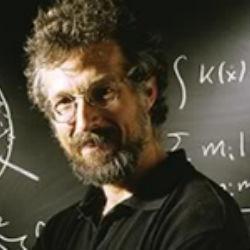Emeriti

- Title
- Distinguished Professor
- Division Physical & Biological Sciences Division
- Department
- Mathematics Department
- Affiliations Office of Sponsored Projects, Physics Department
- Phone 831-459-4841
- Fax 831-459-3260
- Website
- Office Location
- McHenry Library, McHenry Building Room #4120
- Mail Stop Mathematics Department
- Mailing Address
- 1156 High Street
- Santa Cruz CA 95064
- Faculty Areas of Expertise Astronomy, Mathematics, Writing
Summary of Expertise
Differential Geometry. Classical Mechanics. N-body problem.
Research Interests
Since 2000 Richard Montgomery's work has been primarily in two areas: (I) the N-body problem and (II) the geometry of distributions.
I) In 1997 I became obsessed with the 3-body problem from celestial mechanics, a special case of the classical N-body problem, and one of the oldest problems in mathematics and physics. A version of the N-body problem was formulated by Newton, and he sloved it exactly for N=2 in his Principia, recovering Kepler's 3 laws. In a precise sense, Poincare proved at the turn of the last century that the 3-body problem cannot be solved exactly "is not integrable". Like Galois's impossibility proof, Poincare's 'impossible' lead to an enormous body of work, perhaps most notably as the root of the "chaos theory" popular in the late 70s (a.k.a. nonlinear dynamics). my best work to date is probably my 2000 paper with Chenciner. You can read more about it HERE:
http://www.scholarpedia.org/article/N-body_choreographies
My methods include calculus of variations, some Lie group theory, and the geometry of the "shape space" of similarity classes of triangles.
II) By a"distribution" I mean a linear sub-bundle of the tangent bundle of manifold. My interest began through exploring connections (a pun) between how cats land on their feet, how micro-organisms swim and gauge theory, connections initiated by A. Shapere and F. Wilczek (a recent Nobel laureate, for something else). In the cat problem the distribution is defined by the condition "total angular momentum equals zero". If one imposes a metric on the distribution planes and looks for the shortest paths ("best ways to land on one's feet") one arrives naturally at "subRiemannian Geometry".
A very special type of distribution arises out of the problem of curves in the plane, the kth order derivatives of such a curve, compactified, form a kind of universal space for a certain type of distributions called "Goursat distributions". I have written a series of papers and one book on these, inspired by my collaborator, singularity theorist M. Zhitomirskii. In about 2006, we discovered the spaces for these distributions had been studied by algebraic geometers under the name of "Semple Tower" and "Nash blow-up". The semple tower and Nash blow-up for surfaces in space, as opposed to curves in a plane is poorly understood and is one of the focusses of my research since 2008.
Most of the other papers listed here can be characterized as "applied differential geometry" or "mechanics". I enjoy working with people from other disciplines.
Biography, Education and Training
B.A., Sonoma State University
Ph.D., University of California, Berkeley
Honors, Awards and Grants
American Mathematical Society Fellow
Selected Publications
R. Montgomery with M . Zhitomirskii: Points and Curves in the Monster Tower, Memoirs of the AMS, v. 205 (2010).
- R. Montgomery with Gil Bor: $G_2$ and the Rolling Distribution, L'Enseignement Mathematique, v. 55, 157-196, (2009).
- R. Montgomery with V. Swaminathan and M. Zhitomirskii: Resolving Singularities Using Cartan's Prolongation, Journal of Fixed Point Theory and Applications (Arnol'd volume); v. 3, no. 2, Sept. (2008).
- R. Montgomery with Duncan Ralph and Onuttom Narayan: Exact Identities for Nonlinear Wave Propagation, Phys Rev E., v. 77, 056219, May (2008).
- R.Montgomery with Alex Castro: The Chains of Left-invariant CR-Structures on SU(2), Pac. J. Math., v. 238, no. 1, 41-71, (2008).
Selected Exhibitions
Teaching Interests
I have taught `Classical Geometries' umpteen times and still enjoy it.
This class is aimed primarily at those who might teach geometry and high school
but our high performing graduate school bound junior and seniors enjoy it also.
It is taught in an interactive style and aimed at reversing the tide
of stripping geometry out of the high school curricululum.
I typically teach this course, one other upper division undergraduate course
and two graduate courses per year.
